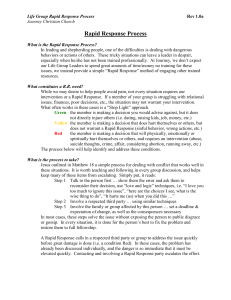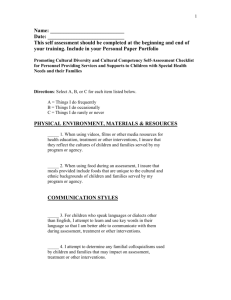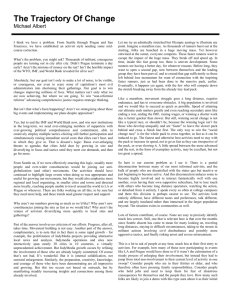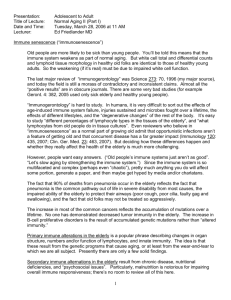Becoming Culturally Competent Is a Journey
advertisement
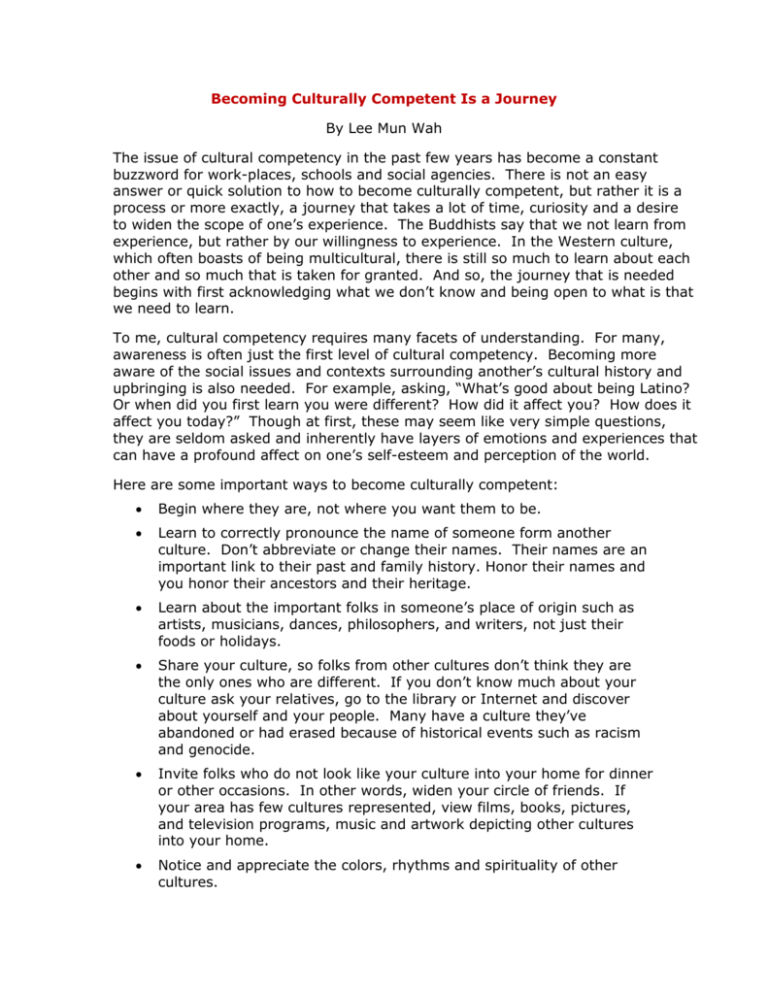
Becoming Culturally Competent Is a Journey By Lee Mun Wah The issue of cultural competency in the past few years has become a constant buzzword for work-places, schools and social agencies. There is not an easy answer or quick solution to how to become culturally competent, but rather it is a process or more exactly, a journey that takes a lot of time, curiosity and a desire to widen the scope of one’s experience. The Buddhists say that we not learn from experience, but rather by our willingness to experience. In the Western culture, which often boasts of being multicultural, there is still so much to learn about each other and so much that is taken for granted. And so, the journey that is needed begins with first acknowledging what we don’t know and being open to what is that we need to learn. To me, cultural competency requires many facets of understanding. For many, awareness is often just the first level of cultural competency. Becoming more aware of the social issues and contexts surrounding another’s cultural history and upbringing is also needed. For example, asking, “What’s good about being Latino? Or when did you first learn you were different? How did it affect you? How does it affect you today?” Though at first, these may seem like very simple questions, they are seldom asked and inherently have layers of emotions and experiences that can have a profound affect on one’s self-esteem and perception of the world. Here are some important ways to become culturally competent: Begin where they are, not where you want them to be. Learn to correctly pronounce the name of someone form another culture. Don’t abbreviate or change their names. Their names are an important link to their past and family history. Honor their names and you honor their ancestors and their heritage. Learn about the important folks in someone’s place of origin such as artists, musicians, dances, philosophers, and writers, not just their foods or holidays. Share your culture, so folks from other cultures don’t think they are the only ones who are different. If you don’t know much about your culture ask your relatives, go to the library or Internet and discover about yourself and your people. Many have a culture they’ve abandoned or had erased because of historical events such as racism and genocide. Invite folks who do not look like your culture into your home for dinner or other occasions. In other words, widen your circle of friends. If your area has few cultures represented, view films, books, pictures, and television programs, music and artwork depicting other cultures into your home. Notice and appreciate the colors, rhythms and spirituality of other cultures. Let folks know that you see their color and acknowledge yours. Colorblindness is just another form of denial and marginalizing. Talk about racism, sexism, and classism. Even though you may not believe it exists, doesn’t mean is doesn’t happen. Be curious, empathetic and open to another reality outside of your own. Be prepared when someone brings up your ethnicity and what it means to them. Try not to take it personally if they say something negative, rather listen and ask lots of questions. Be open to how they are feeling, even if it takes the form of anger or hurt. They need to talk and trust that you will listen and be understanding. When someone talks about racism or other isms, believe them, be curious, and be supportive and not a part of the problem. Avoid making fun of other cultures or telling ethnic jokes. All stereotypes whether negative or positive are simply generalizations or marginalizing. When someone is upset, reflect back what it is they said. Use their words. Notice what someone is saying and what they are not. Try to understand how someone’s past affects who they are and how those experiences might affect their relationship with you. Stay with the process and the relationship, not just the solution. Be curious and open to what they are trying to say. Emotionally relate to how they are feeling. Nurture the relationship. Be present, not too far back or too ahead. Stay in the moment. While communicating notice the impact of your words and not just your good intentions. When someone is angry, try asking, “What angered you about what happened? What hurt you about what happened? What’s familiar about this? What do you need or want?” Listen without interrupting. Reflect back what you hear. Stay neutral and be empathetic. Most folks are often afraid of discussing diversity issues for fear of saying something wrong that might hurt or offend someone. Good luck. This country has had five hundred years of “don’t ask, don’t tell policy” when it comes down to diversity issues. More than likely you will say something that will hurt or be painful to someone. The important thing is to take responsibility for you mistake and be open to talking about it. Sincerity is far more forgiving when it comes out of love and caring. Secondly, stay in the room. Developing a trusting and understanding relationship takes time, especially when there have been past hurts and hundreds of unfinished conversations that took place long before they ever met you. Yet, all relationships, like good gardens take a while to grow and to blossom. They can’t be rushed. They grow and develop at their own time and place. There is an old Buddhist saying, “If you knew someday you were going to be very happy, would you be in such a rush?” Take your time and let go of your expectations. A good and trusting relationship with someone is something to treasure and to nurture. The time you take now to develop the friendship will be the foundation that they will rely on and remember in the years to ahead when there is misunderstanding or crisis. Enjoy the journey. Copyright © 2005 StirFry Seminars and Consulting 2311 8th Street · Berkley CA 94710 · 510-204-8840 www.stirfryseminars.com

